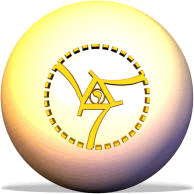Page Back to: EARTH ANGELS
Inspired Public Figures
The public figures below are all active in helping the world. They all contribute in different ways. ALL of them are examples of being part of the solution. Most of the information was gleaned from the entries on Wikipedia web site. Most of the additional photos were acquired through Mayflower (click below to view each entry).
Peacemakers
- President Jimmy Carter, King Hussein, Anwar Sadat and
Menachem Begin - President Bill Clinton, King Hussein, Yitzach Rabin and Yasser Arafat
- Mahatma Gandhi
- Nelson Mandela and F. W. de Klerk
Dynamic Public Motivators
Paragons
YOU CAN HELP US ADD OTHERS TO THE LIST: GO TO MAIN EARTH ANGEL PAGE TO LEARN HOW
The Peacemakers are probably the most important to the healing of the world. What may surprise you is that all the parties involved are peacemakers, whether they are aware of it or not. From a spiritual perspective these individuals were born to bring peace, irrespective of whether or not they are successful.
US President JIMMY CARTER, KING HUSSEIN of Jordan, Israeli Prime Minister MENACHEM BEGIN and
Egyptian President ANWAR SADAT
Because we’ve only included some of the figures in the video, I will show all the peacemakers involved in the event. President Jimmy Carter – King Hussein of Jordan helped broker the peace talks between– Egyptian President Anwar Sadat and Israeli Prime Minister Menachem Begin, which led to the Camp David peace talks in 1978, where Egypt was the first Arab nation to recognize Israel’s right to exist.
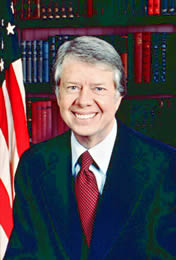
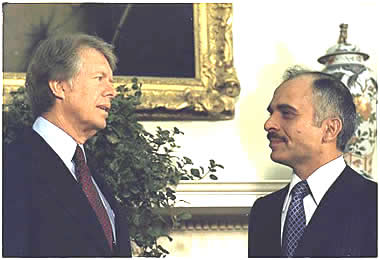
From left to right US President Jimmy Carter, official photo and with King Hussein of Jordan
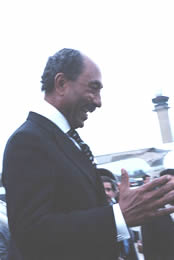
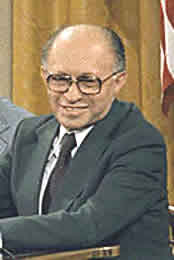
From left to right - Egyptian President Anwar Sadat and Israeli Prime Minister Menachem Begin
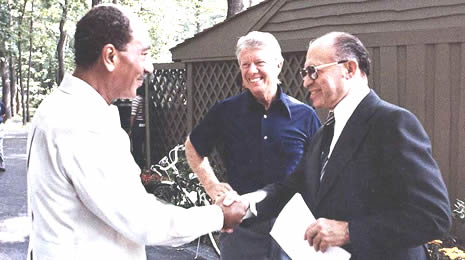
From Left to right – Egyptian President Anwar Sadat, US President Jimmy Carter and Israeli Prime Minister Menachem Begin at Camp David in 1978
US President BILL CLINTON, KING HUSSEIN of Jordan, Israeli Prime Minister YITZACK RABIN and
Palestinian Chairman YASSER ARAFAT
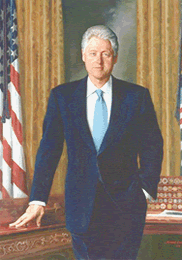
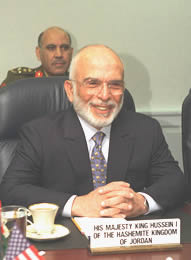
From left to right - US President Bill Clinton & King Hussein of Jordan
Fast-forward 15 years to 1993 and although the peacemaker King Hussein is still there the other peacemakers have changed. Still, the play is still the same. This time it is US President Bill Clinton, Israeli Prime Minister Yitzhak Rabin and Palestinian Chairman Yasser Arafat. Once again, King Hussein of Jordan was engaged in the negotiations.
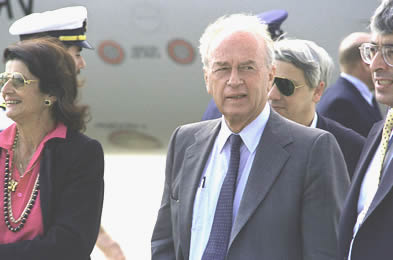
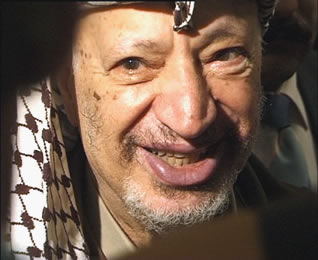
From left to right Israeli Prime Minister Yitzack Rabin & Palestinian Chairman Yasser Arafat
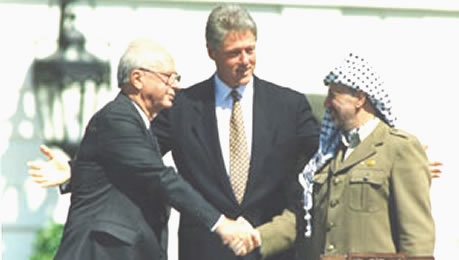
Historic moment for peace, US President Bill Clinton (center) facilitates a brief peace in the Middle East when he brings together former enemies, (left) Israeli Prime Minister Yitzach Rabin and (right) Palestinian Chairman Yasser Arafat.
Before Prime Minister Rabin’s tragic assassination, the world held the hope of peace at last between Israel and Palestine. Although Peace in the Middle East was not achieved, the event of an Israeli Prime Minister shaking hands with the Chairman of the Palestinian government shows how when two people put their differences aside for the sake of others, then Peace is possible. We believe that there are two such people in both the Israeli and Palestinian governments that are capable of this. They only need to step forward, and like Presidents Carter and Clinton and King Hussein stepped forward before, other Peacemakers will also step forward to help.
This next group is included in the peacemakers because they were instrumental in righting the injustices by mostly peaceful means.
Back to List at Top of Page
MAHATMA GANDHI
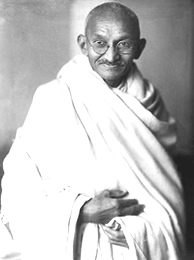
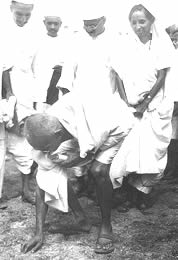
From left to right - Studio photo of Mahatma Gandhi - and Gandhi at Dandi, South Gujarat, picking salt on the beach at the end of the Salt March, 5 April 1930. Behind him is his second son Manilal Gandhi and Mithuben Petit
Mahatma Gandhi succeeded in ending colonial rule by the British through passive resistance. He instructed his followers not to retaliate when the British soldiers beat them. Gandhi showed that it is very hard for essentially decent human beings to continually use violence against a passive resister. An excellent article on Wikipedia explains the impact this peacemaker had:
Non-cooperation and peaceful resistance were Gandhi’s “weapons” in the fight against injustice. In Punjab, the Jallianwala Bagh massacre of civilians by British troops caused deep trauma to the nation, leading to increased public anger and acts of violence. Gandhi criticized both the actions of the British Raj and the retaliatory violence of Indians. He authored the resolution offering condolences to British civilian victims and condemning the riots, which after initial opposition in the party, was accepted following Gandhi’s emotional speech advocating his principle that all violence was evil and could not be justified. But it was after the massacre and subsequent violence that Gandhi’s mind focused upon obtaining complete self-government and control of all Indian government institutions, maturing soon into Swaraj or complete individual, spiritual, political independence.
In December 1921, Gandhi was invested with executive authority on behalf of the Indian National Congress. Under his leadership, the Congress was reorganized with a new constitution, with the goal of Swaraj…Gandhi expanded his non-violence platform to include the swadeshi policy – the boycott of foreign-made goods, especially British goods. Linked to this was his advocacy that khadi (homespun cloth) be worn by all Indians instead of British-made textiles. Gandhi exhorted Indian men and women, rich or poor, to spend time each day spinning khadi in support of the independence movement. This was a strategy to inculcate discipline and dedication to weed out the unwilling and ambitious, and to include women in the movement…
“Non-cooperation” enjoyed wide-spread appeal and success, increasing excitement and participation from all strata of Indian society. Yet, just as the movement reached its apex, it ended abruptly as a result of a violent clash…in February 1922. Fearing that the movement was about to take a turn towards violence, and convinced that this would be the undoing of all his work, Gandhi called off the campaign of mass civil disobedience. Gandhi was arrested on March 10, 1922, tried for sedition, and sentenced to six years imprisonment. Beginning on March 18, 1922, he only served about two years of the sentence, being released in February 1924 after an operation for appendicitis.
Without Gandhi’s uniting personality, the Indian National Congress began to splinter during his years in prison, splitting into two factions, one…favouring party participation in the legislatures, and the other…opposing this move. Furthermore, cooperation among Hindus and Muslims, which had been strong at the height of the non-violence campaign, was breaking down. Gandhi attempted to bridge these differences through many means, including a three-week fast in the autumn of 1924, but with limited success…
On December 31, 1929, the flag of India was unfurled in Lahore. January 26, 1930 was celebrated by the Indian National Congress…as India’s Independence Day. This day was commemorated by almost every other Indian organization. Making good on his word, he launched a new satyagraha against the tax on salt in March 1930, highlighted by the famous Salt March to Dandi…marching 400 kilometres (248 miles) from Ahmedabad to Dandi, Gujarat to make salt himself. Thousands of Indians joined him on this march to the sea. This campaign was one of his most successful at upsetting British rule; Britain responded by imprisoning over 60,000 people…
The Gandhi-Irwin Pact was signed in March 1931. The British Government agreed to set all political prisoners free in return for the suspension of the civil disobedience movement…Lord Irwin’s successor, Lord Willingdon, embarked on a new campaign of repression against the nationalists. Gandhi was again arrested, and the government attempted to destroy his influence by completely isolating him from his followers…In 1932, through the campaigning of the Dalit leader B. R. Ambedkar, the government granted untouchables separate electorates under the new constitution. In protest, Gandhi embarked on a six-day fast in September 1932, successfully forcing the government to adopt a more equitable …This was the start of a new campaign by Gandhi to improve the lives of the untouchables, whom he named Harijans, the children of God. On May 8, 1933 Gandhi began a 21-day fast of self-purification to help the Harijan movement.
In the summer of 1934, three unsuccessful attempts were made on his life.
When the Congress Party chose to contest elections and accept power under the Federation scheme, Gandhi decided to resign from party membership. He did not disagree with the party’s move, but felt that if he resigned, his popularity with Indians would cease to stifle the party’s membership…Gandhi also did not want to prove a target for Raj propaganda by leading a party that had temporarily accepted political accommodation with the Raj.
Gandhi returned to the head in 1936, with the Nehru presidency and the Lucknow session of the Congress…Gandhi had a clash with Subhas Bose, who had been elected to the presidency in 1938. Gandhi’s main points of contention with Bose were his lack of commitment to democracy, and lack of faith in non-violence. Bose won his second term despite Gandhi’s criticism, but left the Congress when the All-India leaders resigned en masse in protest against his abandonment of the principles introduced by Gandhi…
Gandhi and the entire Congress Working Committee were arrested in Bombay by the British on August 9, 1942. Gandhi was held for two years in the Aga Khan Palace in Pune…He was released before the end of the war on May 6, 1944 because of his failing health and necessary surgery; the Raj did not want him to die in prison and enrage the nation…At the end of the war, the British gave clear indications that power would be transferred to Indian hands. At this point Gandhi called off the struggle, and around 100,000 political prisoners were released, including the Congress’s leadership.
Gandhi advised the Congress to reject the proposals the British Cabinet Mission offered in 1946, as he was deeply suspicious of the grouping proposed for Muslim-majority states—Gandhi viewed this as a precursor to partition…The partition plan was approved by the Congress leadership as the only way to prevent a wide-scale Hindu–Muslim civil war. Congress leaders knew that…it was impossible for the Congress to go ahead without his agreement…Gandhi’s closest colleagues had accepted partition as the best way out, and Sardar Patel endeavoured to convince Gandhi that it was the only way to avoid civil war. A devastated Gandhi gave his assent.
On the day of the transfer of power, Gandhi did not celebrate independence with the rest of India, but was alone in Calcutta, mourning the partition and working to end the violence. After India’s independence, Gandhi focused on Hindu–Muslim peace and unity. He conducted extensive dialogue with Muslim and Hindu community leaders, working to cool passions in northern India, as well as in Bengal. Despite the Indo-Pakistan War of 1947, he was troubled when the Government decided to deny Pakistan the Rs. 55 crores due as per agreements made by the Partition Council…Gandhi was also devastated when demands resurged for all Muslims to be deported to Pakistan, and when Muslim and Hindu leaders expressed frustration and an inability to come to terms with one another. He launched his last fast-unto-death in Delhi, asking that all communal violence be ended once and for all, and that the payment of Rs. 55 crores be made to Pakistan. Gandhi feared that instability and insecurity in Pakistan would increase their anger against India, and violence would spread across the borders. He further feared that Hindus and Muslims would renew their enmity and precipitate into an open civil war. After emotional debates with his life-long colleagues, Gandhi refused to budge, and the Government rescinded its policy and made the payment to Pakistan. Hindu, Muslim and Sikh community leaders…assured him that they would renounce violence and call for peace. Gandhi thus broke his fast by sipping orange juice.
On January 30, 1948, Gandhi was shot and killed…The assassin…was a Hindu radical with links to the extremist Hindu Mahasabha, who held Gandhi responsible for weakening India by insisting upon a payment to Pakistan…
According to his wish, the majority of Gandhi’s ashes were immersed in some of the world’s major rivers, such as The Nile, Volga, Thames, etc. A small portion was sent to Paramahansa Yogananda from Dr. V.M. Nawle…encased in a brass & silver coffer. The ashes were then enshrined at the Mahatma Gandhi World Peace Memorial in the Self-Realization Fellowship Lake Shrine within a thousand-year-old stone sarcophagus from China.
It is interesting to see that in death Gandhi was even more influential. His principles are recorded for posterity in the article:
Truth:
Gandhi dedicated his life to the wider purpose of discovering truth, or Satya. He tried to achieve this by learning from his own mistakes and conducting experiments on himself. He called his autobiography The Story of My Experiments With Truth.
Gandhi stated that the most important battle to fight was overcoming his own demons, fears, and insecurities. Gandhi summarized his beliefs first when he said “God is Truth”. He would later change this statement to “Truth is God”. Thus, Satya (Truth) in Gandhi’s philosophy is “God”.
Nonviolence:
The concept of nonviolence (ahimsa) and nonresistance has a long history in Indian religious thought and has had many revivals in Hindu, Buddhist, Jain, Jewish and Christian contexts. Gandhi explains his philosophy and way of life in his autobiography…He was quoted as saying:
- “When I despair, I remember that all through history the way of truth and love has always won. There have been tyrants and murderers and for a time they seem invincible, but in the end, they always fall — think of it, always.”
- “What difference does it make to the dead, the orphans, and the homeless, whether the mad destruction is wrought under the name of totalitarianism or the holy name of liberty and democracy?”
- “An eye for an eye makes the whole world blind.”
- “There are many causes that I am prepared to die for but no causes that I am prepared to kill for.”
NELSON MANDELA and F. W. de KLERK Presidents of SOUTH AFRICA
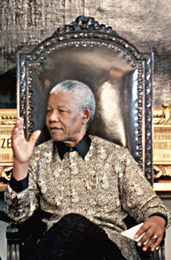
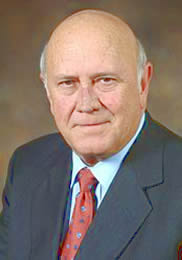
From left to right President Nelson Mandela & President F.W. de Klerk
It may surprise some people to see Nelson Mandela listed as a peacemaker, because he was the head of the African National Congress, which was an antiapartheid activist organization. Nonetheless, although Chairman Yasser Arafat was associated with militants, he was still a peacemaker, because he was at least willing to negotiate. Nelson Mandela is a peacemaker, because on his release from prison, after 27 years he worked to heal South Africa, becoming its first freely elected African President. As I said all parties involved in achieving peace are peacemakers. This is epitomized when in 1993, both Nelson Mandela and the former head of the Apartheid regime, President F.W. de Klerk was awarded the Nobel Peace Prize.
Back to List at Top of Page
AL GORE
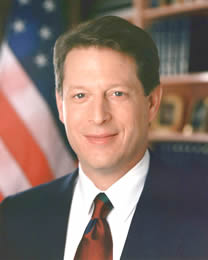
Official photo of Vice President Al Gore
A perfect example of the inspiration to influence public opinion is the former Vice President, Al Gore. His greatest influence was when he became the face responsible for making us aware that the Earth needs help, Al Gore. His and Kevin Wall of Save Our Selves producing the Live Earth concerts on 7,7,07 greatly contributed to the process of everyone can make a difference.
Al Gore became an advocate for the environment when he was Vice President. I will let others relate the impact this Earth Angel has had. The environment has been his focus for many years. According to the entry on Wikipedia “Gore has had many epithets directed at him, such as the ‘Noah of Modern Times’, and ‘The Environment Evangelist’… According to a February 27, 2007 article in TheConcord Monitor, “Gore was one of the first politicians to grasp the seriousness of climate change and to call for a reduction in emissions of carbon dioxide and other greenhouses gases. He held the first congressional hearings on the subject in the late 1970s.” During his tenure in Congress, Gore co-sponsored hearings on toxic waste in 1978–79, and hearings on global warming in the 1980s.
On Earth Day 1994, Gore launched the GLOBE program, an education and science activity that, according to Forbes magazine, “made extensive use of the Internet to increase student awareness of their environment”.
In the late 1990s, Gore strongly pushed for the passage of the Kyoto Treaty, which called for reduction in greenhouse gas emissions…
Gore starred in the documentary film An Inconvenient Truth, which won the 2007 Academy Award for Documentary Feature…Gore gave a brief speech: “My fellow Americans, people all over the world, we need to solve the climate crisis. It’s not a political issue; it’s a moral issue. We have everything we need to get started, with the possible exception of the will to act. That’s a renewable resource. Let’s renew it.”
Back to List at Top of Page
OPRAH WINFREY
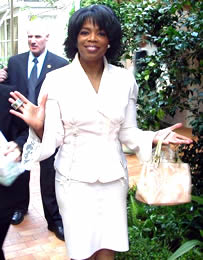
Oprah Winfrey is probably one of the most recognizable celebrities who influences public opinion. She has most certainly earned her place as an Earth Angel by tirelessly working for the less fortunate. Oprah has used her money and position to benefit many people. It would be impossible for me to give a better summary of Oprah’s charitable works than the entry for her philanthropy on Wikipedia. I have excerpted the most salient points:
In 1998, Winfrey began Oprah’s Angel Network, a charity aimed at encouraging people around the world to make a difference in the lives of underprivileged others. Accordingly, Oprah’s Angel Network supports charitable projects and provides grants to nonprofit organizations around the world that share this vision. To date, Oprah’s Angel Network has raised more than $51,000,000…Winfrey personally covers all administrative costs associated with the charity, so 100% of all funds raised go to charity programs.
…behind the scenes Winfrey personally donates more of her own money to charity than any other show-business celebrity in America. In 2005 she became the first black person listed by Business Week as one of America’s top 50 most generous philanthropists, having given an estimated $303 million. Winfrey was the 32nd most philanthropic.
In the wake of Hurricane Katrina, Oprah asked her viewers to open their hearts—and they did. As of September 2006, donations to the Oprah Angel Network Katrina registry total more than $11 million. Homes have been built in four states—Texas, Mississippi, Louisiana, Alabama—before the one year anniversary of Hurricanes Katrina and Rita. Winfrey also matched her viewers’donations by personally giving $10 million to the cause.
Winfrey has also put 250 African-American men through college.Winfrey was the recipient of the first Bob Hope Humanitarian Award at the 2002 Emmy Awards for services to television and film…
In 2004, Winfrey and her team…travelled to South Africa to bring attention to the plight of young children affected by poverty and AIDS. During the 21-day whirlwind trip, Winfrey and her crew visited schools and orphanages in poverty-stricken areas, and at different set-up points in the areas distributed Christmas presents to 50,000 children, with dolls for the girls and soccer balls for the boys. In addition, each child was given a backpack full of school supplies and received two sets of school uniforms for their gender, in addition to two sets of socks, two sets of underwear, and a pair of shoes. Throughout the show, Winfrey appealed to viewers to donate money to Oprah’s Angel Network for poor and AIDS-affected children in Africa, and pledged that she personally would oversee where that money was spent. From that show alone, viewers around the world donated over $7,000,000.
Winfrey invested $40 million and much of her time establishing the Oprah Winfrey Leadership Academy for Girls near Johannesburg in South Africa. The school opened in January, 2007. Nelson Mandela praised Winfrey for overcoming her own disadvantaged youth to become a benefactor for others and for investing in the future of South Africa.
Back to List at Top of Page
ANDERSON COOPER
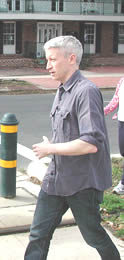
Anderson Cooper marching on January 11, 2007 in New Orleans against violence.
We have all been impressed with this Earth Angel. As a major News anchor he has the ear of millions of viewers. However, he also appears to be a very compassionate man, as was seen in his visible distress for the plight of the victims of Hurricane Katrina. Moreover, he cares deeply about the environment. Showcasing the need for conservation in his Planet in Peril series. We found two articles on the web, which perfectly sum up Anderson Cooper’s impact.
June 6, 2007 – The National Association for Multi-ethnicity in Communications (NAMIC) has named veteran journalist Anderson Cooper, host of CNN’s “Anderson Cooper 360,” as the recipient of the 2007 Mickey Leland Humanitarian Achievement Award. The announcement was made today by Alicin Reidy-Williamson, board chair, NAMIC and senior vice president of Corporate Responsibility and Public Affairs for MTV Networks. David L. Cohen, executive vice president, Comcast Corporation and Andrew T. Heller, president of Domestic Distribution for Turner Broadcasting System, Inc. are the 2007 Honorary Co-Chairs. Scheduled for September 16-18, 2007, the 21st Annual NAMIC Conference will be held in Manhattan at the Hilton New York.
Presented in conjunction with the Annual NAMIC Conference, the Mickey Leland Humanitarian Achievement Award was established in 1992 in memory of the late Congressman from Texas and his lifelong advocacy of social justice and equality for people around the world. By recognizing Cooper, NAMIC continues its tradition of honoring individuals and organizations affiliated with the communications industry that demonstrate a commitment to advancing the causes and concerns of people of color. “NAMIC is pleased to honor such a worthy recipient,” said Reidy-Williamson, “It is a privilege to pay homage to a member of our industry that has fostered a sense of humanism in today’s media.”
Past award recipients include Robert L. Johnson, founder of Black Entertainment Television; George Herrera, former president and CEO, U.S. Hispanic Chamber of Commerce; Bill Richardson, former ambassador, United Nations; Soledad O’Brien, award-winning journalist; Kweisi Mfume, former NAACP president; and Christina Saralegui, host of the Galavision/Univision “Christina Show” among others.
An Emmy award-winning journalist, author and television personality, Cooper has covered major world events such as post-Hurricane Katrina along the Gulf Coast, the Afghanistan War post-September 11, South Asia tsunami, the Iraqi elections in Baghdad, the funeral of Pope John Paul II in the Vatican City and the famine in Somalia for which he was awarded a Bronze Telly.
“It’s a tremendous honor to be recognized by NAMIC and to honor the important work they do promoting diversity in the communications industry,” commented Anderson Cooper. “I am humbled to be receiving an award that pays tribute to Congressman Leland’s legacy, and will do my best to live up to it in all my journalistic endeavors.”
CNN's Anderson Cooper will anchor ANDERSON COOPER 360º from the Democratic Republic of the Congo from Wednesday, October 4, through Friday, October 6, as part of the program’s weeklong emphasis on violence and political turmoil in several African nations.
Ethnic strife and a civil war in Congo have been responsible for the deaths of more than 3 million people since 1998. As many as 1,250 people there die every day, mostly from hunger and disease.
The program will also focus on the Darfur region of Sudan where violence continues to rage. Africa correspondent Jeff Koinange provides updates on the continuing genocide there as well as ethnic and political conflicts. In addition, CNN senior medical correspondent Dr. Sanjay Gupta visits refugee camps along the border of Sudan and Chad to report on the medical conditions of refugees fleeing the brutal fighting between the two countries.
ANDERSON COOPER 360º is a wide-ranging, unconventional news program that takes a full 360-degree look at the world’s events. The program showcases CNN’s worldwide newsgathering capabilities as well as Anderson Cooper’s unique sensibilities and perspective through a diverse range of live reports and interviews
Back to List at Top of Page
We’ve chosen to name this section paragons, because although, all of the Earth Angels are equally affective in humanitarian efforts, these individuals are the faces that epitomize Humanitarianism. Their faces are instantly recognizable as the representatives of charitable works and promoters of peace.
MOTHER TERESA
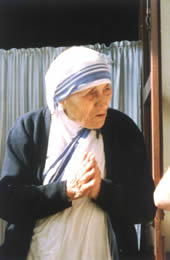

Mother Teresa and the home for the dying in Calcutta, which she founded.
The picture to the right of Mother Teresa is her home for the dying in Calcutta, this picture was used in the article on her and perfectly depicts what Mother Teresa did. Therefore we will let the excerpt from the article on Wikipedia relate why she is listed as a paragon.
On September 10, 1946, Teresa experienced what she later described as “the call within the call” while traveling to the Loreto convent in Darjeeling for her annual retreat. “I was to leave the convent and help the poor while living among them. It was an order. To fail would have been to break the faith.” She began her missionary work with the poor in 1948, replacing her traditional Loreto habit with a simple white cotton chira decorated with a blue border and then venturing out into the slums.” Initially she started a school in Motijhil; shortly thereafter, she started tending to the needs of the destitute and starving. Her efforts quickly caught the attention of Indian officials, including the Prime Minister, who expressed his appreciation.
Teresa wrote in her diary that her first year was fraught with difficulties. She had no income and had to resort to begging for food and supplies. Teresa experienced doubt, loneliness and the temptation to return to the comfort of convent life during these early months. She recorded in her diary: “Our Lord wants me to be a free nun covered with the poverty of the cross. Today I learned a good lesson. The poverty of the poor must be so hard for them. While looking for a home I walked and walked till my arms and legs ached. I thought how much they must ache in body and soul, looking for a home, food and health. Then the comfort of Loreto [her former order] came to tempt me. ‘You have only to say the word and all that will be yours again,’ the Tempter kept on saying ... Of free choice, my God, and out of love for you, I desire to remain and do whatever be your Holy will in my regard. I did not let a single tear come.”
Teresa received Vatican permission on October 7, 1950 to start the diocesan congregation that would become the Missionaries of Charity. Its mission was to care for, in her own words, “the hungry, the naked, the homeless, the crippled, the blind, the lepers, all those people who feel unwanted, unloved, uncared for throughout society, people that have become a burden to the society and are shunned by everyone.” It began as a small order with 13 members in Calcutta; today it has more than 4,000 nuns running orphanages, AIDS hospices, and charity centers worldwide, and caring for refugees, the blind, disabled, aged, alcoholics, the poor and homeless, and victims of floods, epidemics, and famine.
In 1952 Mother Teresa opened the first Home for the Dying in space made available by the City of Calcutta. With the help of Indian officials she converted an abandoned Hundu temple into the Kalighat Home for the Dying, a free hospice for the poor. She renamed it Kalighat, the Home of the Pure Heart (Nirmal Hriday). Those brought to the home received medical attention and were afforded the opportunity to die with dignity, according to the rituals of their faith; Muslims were read the Quran, Hindus received water from the Ganges, and Catholics received the Last Rites. “A beautiful death,” she said, “is for people who lived like animals to die like angels — loved and wanted.” Mother Teresa soon opened a home for those suffering from Hansen’s disease, commonly known as leprosy, and called the hospice Shanti Nagar (City of Peace). The Missionaries of Charity also established several leprosy outreach clinics throughout Calcutta, providing medication, bandages and food.
As the Missionaries of Charity took in increasing numbers of lost children, Mother Teresa felt the need to create a home for them. In 1955 she opened the Nirmala Shishu Bhavan, the Children’s Home of the Immaculate Heart, as a haven for orphans and homeless youth.
The order soon began to attract both recruits and charitable donations, and by the 1960s had opened hospices, orphanages, and leper houses all over India. Mother Teresa then expanded the order internationally, with new homes opening throughout the globe. The order’s first house outside India was in Venezuela, opened in 1965 with five sisters. Others followed in Rome, Tanzania, and Austria in 1968; during the 1970s the order would open houses and foundations in dozens of countries in Asia, Africa, Europe, and the United States…
In 1982, at the height of the siege in Beirut, Mother Teresa rescued 37 children trapped in a front line hospital by brokering a temporary cease-fire between the Israeli army and Palestinian guerrillas. Accompanied by Red Cross workers, she traveled through the war zone to the devastated hospital to evacuate the young patients.
When the walls of Eastern Europe collapsed, she expanded her efforts to Communist countries that had previously rejected the Missionaries of Charity, embarking on dozens of projects. She was undeterred by criticism about her firm stand against abortion and divorce stating, “No matter who says what, you should accept it with a smile and do your own work.”
Mother Teresa traveled to assist and minister to the hungry in Ethiopia, radiation victims at Chernobyl, and earthquake victims in Armenia. In 1991, Mother Teresa returned for the first time to her homeland and opened a Missionaries of Charity Brothers home in Tirana, Albania.
By 1996, she was operating 517 missions in more than 100 countries. Over the years, Mother Teresa’s Missionaries of Charity grew from twelve to thousands serving the “poorest of the poor” in 450 centers around the world. The first Missionaries of Charity home in the United States was established in the South Bronx, New York; by 1984 the order operated nineteen establishments throughout the country…
Back to List at Top of Page
PRINCESS DIANA
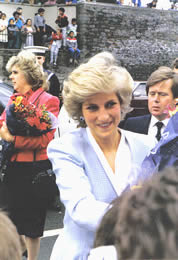
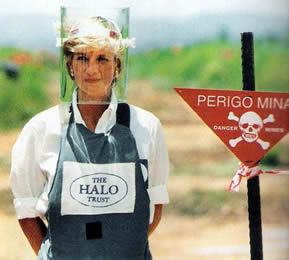
From left to right - Princess Diana greeting the crowds as the Princess of Wales, and in Angola in front of a sign warning of landmines.
After seeing Princess Diana with Mother Teresa, it seems fitting that these two remarkable women are honored in the same place. Her main focus was on the eradication of land mines as is depicted in the photo above. The entry on Wikipedia had the most comprehensive article on Princess Diana’s charity work:
Starting in the mid- to late 1980s, the Princess of Wales became well known for her support of several charity projects. This stemmed naturally from her role as Princess of Wales - she was expected to engage in hospital visitations where she comforted the sick and in so doing, assumed the patronage of various charitable organisations - and from an interest in certain illnesses and health-related matters. Owing to Public Relations efforts in which she agreed to appear as a figurehead, Diana used her influential status to positively assist the campaign against landmines, a cause which won the Nobel Prize in 1997 in tribute, and with helping to decrease discrimination against victims of AIDS.
In April 1987, the Princess of Wales was one of the first high-profile celebrities to be photographed touching a person infected with HIV at the ‘chain of hope’ organisation. Her contribution to changing the public opinion of AIDS sufferers was summarised in December 2001 by Bill Clinton at the ‘Diana, Princess of Wales Lecture on AIDS’:
“In 1987, when so many still believed that AIDS could be contracted through casual contact, Princess Diana sat on the sickbed of a man with AIDS and held his hand. She showed the world that people with AIDS deserve no isolation, but compassion and kindness. It helped change world's opinion, and gave hope to people with AIDS.” -Bill Clinton.
The pictures of Diana touring an Angolan minefield, in a ballistic helmet and flak jacket, were seen worldwide. It was during this campaign that conservatives accused the Princess of meddling in politics and declared her a ‘loose cannon.’ In August 1997, just days before her death, she visited Bosnia with the Landmine Survivors Network. Her interest in landmines was focused on the injuries they create, often to children, long after a conflict is over.
She is believed to have influenced the signing, though only after her death, of the Ottawa Treaty, which created an international ban on the use of anti-personnel landmines. Introducing the Second Reading of the Landmines Bill 1998 to the British House of Commons, the Foreign Secretary, Robin Cook, paid tribute to Diana’s work on landmines:
“All Honourable Members will be aware from their postbags of the immense contribution made by Diana, Princess of Wales to bringing home to many of our constituents the human costs of landmines. The best way in which to record our appreciation of her work, and the work of NGOs that have campaigned against landmines, is to pass the Bill, and to pave the way towards a global ban on landmines." -Robin Cook
The United Nations appealed to the nations which produced and stockpiled the largest numbers of landmines (China, India, North Korea, Pakistan, Russia, and the United States) to sign the Ottawa Treaty forbidding their production and use, for which Diana had campaigned. Carol Bellamy, Executive Director of the United Nations children’s Fund (UNICEF), said that landmines remained “a deadly attraction for children, whose innate curiosity and need for play often lure them directly into harm’s way”.
Back to List at Top of Page
DALAI LAMA
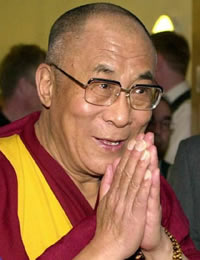
The present Dalai Lama, Tenzin Gyatso
We have listed the Dalai Lama as a paragon, because he epitomizes tolerance on all levels. He has received numerous awards in recognition of his efforts to unite rather than divide. Again the entry for Wikipedia is the most comprehensive. Unfortunately, again we have been forced to excerpt it for the sake of space:
The Dalai Lama endorsed the founding of the Dalai Lama Foundation in order to promote peace and ethics worldwide. The Dalai Lama is not operationally involved with this foundation, though he suggests some overall direction and his office is routinely briefed on its activities. He has also stated his belief that modern scientific findings take precedence over ancient religions… He has also expressed his concern for environmental problems:
“On the global level, I think the ecology problem is very serious. I hear about some states taking it very seriously. That’s wonderful! So this blue planet is our only home, if something goes wrong at the present generation, then the future generations really face a lot of problems, and those problems will be beyond human control; so that’s very serious. Ecology should be part of our daily life.”
- The Dalai Lama, University at Buffalo, The State University of New York, September 19, 2006
In 1996, he described himself as half-Marxist, half-Buddhist:
- Of all the modern economic theories, the economic system of Marxism is founded on moral principles, while capitalism is concerned only with gain and profitability. Marxism is concerned with the distribution of wealth on an equal basis and the equitable utilization of the means of production. It is also concerned with the fate of the working classes—that is the majority—as well as with the fate of those who are underprivileged and in need, and Marxism cares about the victims of minority-imposed exploitation. For those reasons the system appeals to me, and it seems fair…The failure of the regime in the Soviet Union was, for me not the failure of Marxism but the failure of totalitarianism. For this reason I think of myself as half-Marxist, half-Buddhist.
—The Dalai Lama, Friendly Feudalism: The Tibet Myth and Dalai Lama’s answer on various topics
Tenzin Gyatso has on occasion been denounced by the Chinese government as a supporter of Tibetan independence. Over time, he has developed a public position stating that he is not in favour of Tibetan independence and would not object to a status in which Tibet has internal autonomy while the PRC manages some aspects of Tibet’s defense and foreign affairs. In his ‘Middle Way Approach’, he laid down that the Chinese government can take care of foreign affairs and defense, and that Tibet should be managed by an elected body.
On April 18, 2005, Time Magazine placed Tenzin Gyatso on its list of the world’s 100 most influential people.
On June 22, 2006, the Parliament of Canada voted unanimously to make Tenzin Gyatso an honorary citizen of Canada. This marks the third time in history that the Government of Canada has bestowed this honour, the others being Raoul Wallenberg posthumously in 1985 and Nelson Mandela in 2001.
In September 2006, the United States Congress awarded the Dalai Lama the Congressional Gold Medal, the highest award which may be bestowed by the Legislative Branch of the United States government. The decoration is awarded to any individual who performs an outstanding deed or act of service to the security, prosperity, and national interest of the United States of America. Previous winners include Nelson Mandela, George Washington, Pope John Paul II, Martin Luther King, Jr, Mother Teresa and Robert F. Kennedy.
In February 2007, the Dalai Lama was named Presidential Distinguished Professor at Emory University. This was the first time that the leader of the Tibetan exile community accepted a university appointment.
In June 2007, the Dalai Lama made an Australian tour, delivering public talks in Perth, Bendigo, Melbourne, Geelong, Sydney, Canberra and Brisbane.
In recent years he has been campaigning for wildlife conservation, including a religious ruling against wearing tiger and leopard skins as garments…
The Dalai Lama has received numerous awards over his spiritual and political career. Perhaps his most notable award was the Nobel Peace Prize in Oslo on December 10, 1989 (see below). Some other notable awards and honors he has received:
- Honorary citizenship of Ukraine, during the anniversary of the Nobel Prize on December 9 2006 in Mc Leod Ganj
- Jaime Brunet Prize for Human Rights on October 9, 2003
- Hilton Humanitarian Award on September 24, 2003
- International League for Human Rights Award on September 19, 2003
- Life Achievement Award from Hadassah Women’s Zionist Organization on November 24, 1999 Roosevelt Four Freedoms Award from the Franklin and Eleanor Roosevelt Institute on June 4, 1994 World Security Annual Peace Award from the New York Lawyer’s Alliance on April 27, 1994
- Peace and Unity Awards from the National Peace conference on August 23, 1991
- Earth Prize from the United Earth and U.N Environmental Program on June 5, 1991
- Advancing Human Liberty from the Freedom House on April 17, 1991
- Le Prix De La Memoire from the Foundation Danielle Mitterand, France on December 4, 1989
- Raoul Wallenberg Human Rights Award from the Congressional Rights Caucus Human Rights on July 21, 1989…
On December 10th, 1989 Tenzin Gyatso was awarded the Nobel Peace Prize, the chairman of the Nobel committee saying that this was “in part a tribute to the memory of Mahatma Gandhi.” The committee recognized officially his efforts in “the struggle of the liberation of Tibet and the efforts for a peaceful resolution instead of using violence”. In his acceptance speech, he criticised China for the using force against student protesters during the Tiananmen Square protests of 1989. He stated however that their effort was not in vain. His speech focused on the importance of the continued use of non-violence and his desire to maintain a dialogue with China to try to resolve the situation.
Back to List at Top of Page
Back to Top


